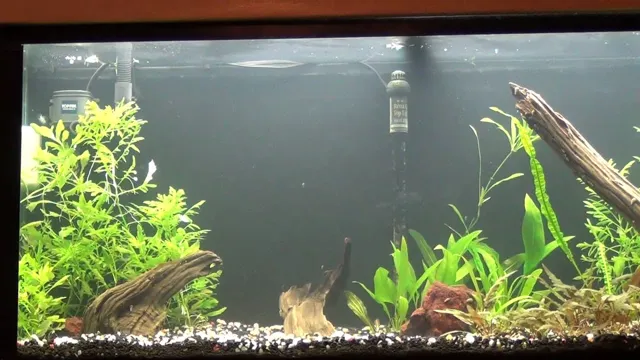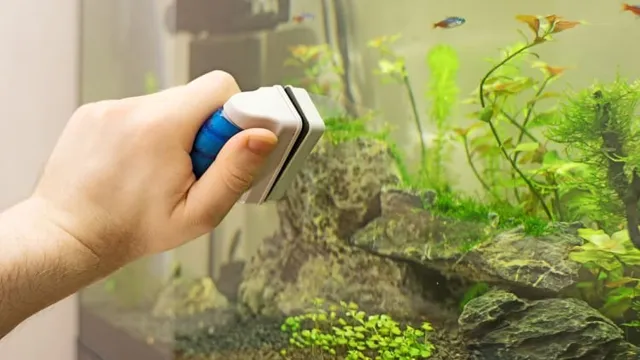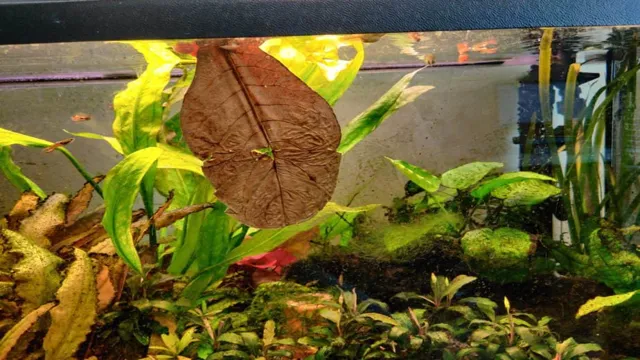Have you noticed a buildup of ammonia in your aquarium? It’s a common problem for aquarium enthusiasts and can be dangerous for your aquatic pets. Ammonia is produced through the breakdown of waste and uneaten food in your tank, which can lead to illness and even death for your fish. But don’t fret, there’s a solution – Prime! Prime is a popular water conditioner that can help lower ammonia levels in your aquarium.
In this blog post, we’ll take a closer look at how Prime works and why it’s an effective solution for your ammonia troubles. So, let’s dive in!
Understanding Ammonia in Aquariums
If you’re an aquarium owner, then you’re probably already familiar with the harmful effects of ammonia in your tank. High levels of ammonia can be detrimental to your fish’s health and can even lead to death in extreme cases. Fortunately, there are ways to lower the ammonia levels in your aquarium, and one such method is by using Prime.
This product is designed to help neutralize ammonia and other harmful toxins in the tank, and it has proven to be highly effective. Simply adding Prime to your aquarium water can help to detoxify the ammonia and make it less dangerous for your fish. So, if you’re worried about high ammonia levels in your aquarium, make sure to use Prime to keep your fish healthy and happy.
What causes ammonia in aquariums?
Ammonia is a common problem in aquariums that can be harmful to your fish. It is a colorless and toxic substance that forms from the breakdown of fish waste and uneaten food in the aquarium. One of the main causes of ammonia in aquariums is overfeeding.
When you feed your fish too much or with food that is too rich, they may not eat everything, and the excess food will begin to decompose, forming ammonia. Another cause of ammonia in aquariums is inadequate filtration or poor maintenance. A dirty filter or failure to change the water regularly will cause a buildup of waste and debris, leading to ammonia buildup.
It is essential to regularly check the water quality in your aquarium and maintain proper filtration to prevent ammonia buildup. In extreme cases, high levels of ammonia can lead to fish fatalities, so it’s crucial to keep on top of it for the health of your aquatic pets.

Why is ammonia harmful to fish?
Ammonia, fish, aquariums Ammonia is a silent enemy for fish keepers as it can become a major cause of stress and death for fish. In aquariums, it is produced by fish waste, excess food, and dead organic matter. While a small amount of ammonia is manageable and necessary for the nitrogen cycle, high levels of ammonia are toxic to fish.
It can burn their gills, leading to respiratory issues and even death. Additionally, it can weaken their immune system and make them more susceptible to diseases and infections. To prevent ammonia toxicity in aquariums, regular water changes, careful feeding, and adequate filtration are necessary.
Testing water parameters frequently is also important to ensure the safety and well-being of your aquatic pets. As a responsible fish keeper, it is our duty to maintain a clean and healthy environment for our aquarium inhabitants, with the aim to reduce the concentration of ammonia in the water to a safe level for all aquatic live beings.
Using Prime to Lower Ammonia Levels
If you’re keeping fish in an aquarium, high levels of ammonia can be a major concern. Luckily, using Prime can be an effective way to lower ammonia levels. Prime is a water conditioner that’s designed to detoxify the harmful chemicals in your aquarium water, including ammonia. (See Also: How to Make a Living off Breeding Aquarium Fish: Tips and Tricks for Profitable Fish Breeding)
It works by binding to the ammonia molecules and converting them into a non-toxic compound that can be easily removed through regular water changes. With regular use, Prime can help to keep ammonia levels in check and provide a healthier environment for your fish to thrive in. Plus, it’s easy to use and doesn’t require any complicated equipment or processes.
Just follow the instructions on the bottle and you’ll be able to see the results in no time. So if you’re looking for a simple and effective way to lower the ammonia levels in your aquarium, give Prime a try!
How does Prime work?
Prime is a popular water conditioner that is commonly used in aquariums to lower ammonia levels. Ammonia is a toxic substance that can build up quickly in fish tanks, putting the health of your aquatic pets at risk. When added to aquarium water, Prime works by breaking down ammonia into a less toxic form called ammonium.
This allows beneficial bacteria in the tank to break down the ammonium and convert it into less harmful substances. However, it’s important to note that Prime does not completely remove ammonia from the water. Regular water changes and proper filtration are still necessary to maintain a healthy environment for your fish.
Overall, using Prime as a part of your aquarium maintenance routine can greatly benefit your fish and help prevent ammonia-related illnesses.
Dos and Don’ts of using Prime
Prime is a popular solution among aquarium enthusiasts for controlling ammonia levels in their tanks. However, there are a few dos and don’ts to keep in mind when using this product. One of the first things you should do is test your water to determine the current ammonia levels before administering Prime.
This will provide you with a baseline to compare after using the product. It’s also important to follow the instructions carefully and not overdose, as this can have adverse effects on your fish and plants. Additionally, make sure to store Prime in a cool, dry place away from sunlight or heat sources.
Remember, Prime is not a substitute for proper aquarium maintenance, so regularly testing your water and performing water changes is still necessary. By following these tips, you can use Prime effectively and safely to keep ammonia levels under control in your aquarium.
Other Methods of Lowering Ammonia
How to lower ammonia in aquarium Prime is a common concern for many aquarium owners. While Prime is certainly a useful product for lowering ammonia levels, there are other methods that can help as well. One option is to increase the amount of live plants in the aquarium, which can help to absorb excess ammonia. (See Also: How to Make an Aquarium Overflow Siphon Tube: A Step-by-Step Guide)
Another technique is to perform more frequent water changes, which will dilute ammonia levels and prevent them from building up to dangerous levels. Finally, adding a water conditioner that specifically targets ammonia can also be effective. Ultimately, the best approach will depend on the specifics of your aquarium and the severity of the ammonia problem.
Monitoring water parameters regularly and taking action as needed is the key to maintaining a healthy and thriving aquatic environment.
Increasing aeration and filtration
Another effective method of reducing ammonia levels in your aquarium is to increase aeration and filtration. The oxygen-rich environment created by aeration can promote the growth of beneficial nitrifying bacteria, which convert ammonia into less harmful substances. You can also improve filtration by using a high-quality filter that can effectively remove waste and debris from the water.
Additionally, consider adding live plants to your aquarium, as they can absorb ammonia and other toxins from the water. Another option is to perform regular water changes to remove excess ammonia and to maintain stable water conditions. By incorporating these methods, you can significantly reduce the ammonia levels in your aquarium, creating a healthier and safer environment for your aquatic pets.
Remember to monitor your water parameters regularly to ensure that your ammonia levels remain at safe levels.
Performing regular water changes
When it comes to lowering ammonia levels in your aquarium, regularly changing out the water isn’t the only solution. Other methods can also be effective in reducing ammonia buildup and keeping your fish healthy. One such approach is to use chemical filtration, such as activated carbon or zeolite.
These materials can help bind and remove ammonia from the water. Another method is to introduce live plants to your tank. Not only do they help absorb ammonia through photosynthesis, but they also provide a natural habitat for your fish.
Additionally, you can introduce beneficial bacteria to your tank through products like bacterial supplements or by using substrate that is already colonized with beneficial bacteria. These bacteria can help break down ammonia into less harmful compounds. Remember, regularly testing your water for ammonia levels and taking action when needed is crucial for maintaining a healthy environment for your aquatic pets.
Conclusion
In conclusion, when it comes to lowering ammonia in your aquarium, Prime is the prime choice! With its unique formula, it not only detoxifies ammonia but also eliminates chlorine and chloramine, making it a triple threat to harmful substances in your tank. So why settle for anything less? Keep your fish happy and healthy with Prime. After all, it’s not just another fish in the sea, it’s your beloved aquatic companion!”
FAQs
What Causes High Ammonia Levels in an Aquarium?
High ammonia levels in an aquarium can be caused by overfeeding, overstocking, dead plant or fish matter, and insufficient filtration.
(See Also: How to Create an Underwater Waterfall in an Aquarium: Tips and Tricks for a Beautiful Tank Setup)
What Are the Dangers of High Ammonia Levels in an Aquarium?
High ammonia levels in an aquarium can be dangerous for fish as it can cause burns and damage their gills, leading to respiratory issues and even death.
What is Prime and How Does It Lower Ammonia Levels?
Prime is a water conditioner that detoxifies ammonia, nitrite, and nitrate in the water. It lowers ammonia levels by binding to the ammonia and converting it into a non-toxic form.
How Much Prime Should You Use to Lower Ammonia Levels in an Aquarium?
The recommended dose is 5 ml of Prime for every 50 gallons of water to lower ammonia levels in an aquarium.
How Often Should You Use Prime to Lower Ammonia Levels in an Aquarium?
Prime can be used daily to lower ammonia levels in an aquarium or as needed depending on the ammonia levels.
Can Plants Help Lower Ammonia Levels in an Aquarium?
Yes, plants can help lower ammonia levels in an aquarium by absorbing and utilizing ammonia for their growth.
How Can You Prevent High Ammonia Levels in an Aquarium?
You can prevent high ammonia levels in an aquarium by feeding your fish moderately, avoiding overstocking, performing regular water changes, and maintaining a good filtration system.







